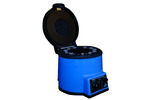Home
- ▶
- Heaters/Source
- ▶
- Agilent Heaters and SensorsMass Spectrometry, Scientific Supplies & ManufacturingScientific Instrument Services 5973 Source Heater Tamper Resistant Allen Wrench 5973/5975 Quad Sensor 5985 Source Heater Assembly Agilent Interface Heater Assembly 5971 Interface Heater

- ▶
- Lab/CleanMicro-Mesh® (Fine Cushioned Abrasive) Aluminum Oxide Cleaning Abrasive Fiberglass Cleaning Brushes Swabs and Applicators Nylon and Latex Gloves Cleaning Wipes SIS MS Source Cleaning Kits Dust-Off® Hurricane Canless Air System Wheaton Bottles Wheaton Vials Wheaton Closures Sterile Vials - Bottle, Stopper, and Cap - All Together Certified Sterile Kimble Chase Clear Serum Vials Soil Sampling Kits Crimpers and Decappers Temperature Measurement & Recording Devices Bullet Blender® Homogenizer The SW 110 Multi-Purpose Spot Welder New Era Syringe Pump Systems Ohaus MB Series Moisture Analyzers Celestron® Handheld Digital Microscope (HDM) Checkit® Pipette Accuracy Test Greenwood Lab Supplies Next Advance Lab Products Catalog Page G1

- ▶
- Next Advance Lab Products
- ▶
- Bullet Blender® HomogenizerBrochure on the Bullet Blender (PDF) Brochure on the Bullet Blender Gold (PDF) Bullet Blender Homogenization Presentation (PDF slides) Bullet Blender Users Guide - Tips and Tricks (PDF) How to use the Bullet Blender (PDF) Bullet Blender® Homogenizer - Protocols Note 99: Volatile and Semi-Volatile Profile Comparison of Whole vs. Dry Homogenized Wheat, Rye and Barley Grains by Direct Thermal Extraction GC/MS Note 100: Volatile and Semi-Volatile Profile Comparison of Whole Versus Cracked Versus Dry Homogenized Barley Grains by Direct Thermal Extraction Catalog Page G14 Catalog Page G15

- LiteratureApplication Notes Adsorbent Resins Guide Mass Spec Tips SDS Sheets FAQ MS Calibration Compound Spectra Manuals MS Links/Labs/ Organizations MS Online Tools Flyers on Products/Services Scientific Supplies Catalog About Us NextAdvance Bullet Blender® Homogenizer Protocols Micro-Mesh® Literature Instrumentation Literature Agilent GC/MS Literature SIS News / E-Mail Newsletter NIST MS Database - Update Notifications

- ▶
- Bullet Blender® Homogenizer - Protocols (This Page)
 Candida albicans Protocol for Candida albicans Homogenization in the Bullet Blender
Candida albicans Protocol for Candida albicans Homogenization in the Bullet Blender Drosophila S2 Cells Protocol for Drosophila S2 Cell Culture Homogenization in the Bullet Blender
Drosophila S2 Cells Protocol for Drosophila S2 Cell Culture Homogenization in the Bullet Blender E. Coli Protocol for E. coli Cultures Homogenization in the Bullet Blender
E. Coli Protocol for E. coli Cultures Homogenization in the Bullet Blender Mammalian Cell Culture Protocol for Mammalian Cell Culture Homogenization in the Bullet Blender
Mammalian Cell Culture Protocol for Mammalian Cell Culture Homogenization in the Bullet Blender Saccharomyces cerevisiae Protocol for Saccharomyces Homogenization in the Bullet Blender
Saccharomyces cerevisiae Protocol for Saccharomyces Homogenization in the Bullet Blender Brain Protocol for Brain Tissue Homogenization in the Bullet Blender
Brain Protocol for Brain Tissue Homogenization in the Bullet Blender Cancer Tissue
Cancer Tissue
(Carcinoma)Protocol for Tumor Homogenization in the Bullet Blender Cartilage Protocol for Cartilaginous Tissue Homogenization in the Bullet Blender
Cartilage Protocol for Cartilaginous Tissue Homogenization in the Bullet Blender Epithelium Protocol for Epithelial Tissue Homogenization in the Bullet Blender
Epithelium Protocol for Epithelial Tissue Homogenization in the Bullet Blender Fat / Adipose Protocol for Adipose Tissue Homogenization in the Bullet Blender
Fat / Adipose Protocol for Adipose Tissue Homogenization in the Bullet Blender Hair Protocol for Hair Homogenization in the Bullet Blender
Hair Protocol for Hair Homogenization in the Bullet Blender Heart Protocol for Cardiac Tissue Homogenization in the Bullet Blender
Heart Protocol for Cardiac Tissue Homogenization in the Bullet Blender Kidney Protocol for Kidney Tissue Homogenization in the Bullet Blender
Kidney Protocol for Kidney Tissue Homogenization in the Bullet Blender Liver Protocol for Hepatic (Liver) Tissue Homogenization in the Bullet Blender
Liver Protocol for Hepatic (Liver) Tissue Homogenization in the Bullet Blender Lung/Trachea Protocol for Lung/Tracheal Tissue Homogenization in the Bullet Blender
Lung/Trachea Protocol for Lung/Tracheal Tissue Homogenization in the Bullet Blender Lymph Node Protocol for Lymphatic Tissue Homogenization in the Bullet Blender
Lymph Node Protocol for Lymphatic Tissue Homogenization in the Bullet Blender Meconium Protocol for Meconium Homogenization in the Bullet Blender
Meconium Protocol for Meconium Homogenization in the Bullet Blender Muscle
Muscle
(Striated)Protocol for Striated Muscle Tissue Homogenization in the Bullet Blender Pharynx Protocol for Pharyngeal Tissue Homogenization in the Bullet Blender
Pharynx Protocol for Pharyngeal Tissue Homogenization in the Bullet Blender Tail Snips Protocol for Tail Snips Homogenization in the Bullet Blender
Tail Snips Protocol for Tail Snips Homogenization in the Bullet Blender Skin Protocol for Dermal (Skin) Tissue Homogenization in the Bullet Blender
Skin Protocol for Dermal (Skin) Tissue Homogenization in the Bullet Blender Spleen Protocol for Splenic (Spleen) Tissue Homogenization in the Bullet Blender
Spleen Protocol for Splenic (Spleen) Tissue Homogenization in the Bullet Blender Stomach / Jejunum Protocol for Jejunum or Stomach Tissue Homogenization in the Bullet Blender
Stomach / Jejunum Protocol for Jejunum or Stomach Tissue Homogenization in the Bullet Blender Uterus Protocol for Uterine Tissue Homogenization in the Bullet Blender
Uterus Protocol for Uterine Tissue Homogenization in the Bullet Blender A. Thaliana Protocol for A. thaliana Homogenization in the Bullet Blender
A. Thaliana Protocol for A. thaliana Homogenization in the Bullet Blender Blueberry
Blueberry
(Vaccinium)Protocol for Blueberry Homogenization in the Bullet Blender Ginger Rhizome
Ginger Rhizome
(Zingiber officinale)Protocol for Ginger Rhizome Homogenization in the Bullet Blender Leek Leaves
Leek Leaves
(Allium ampeloprasum)Protocol for Leek Leaf Homogenization in the Bullet Blender Horseradish Root
Horseradish Root
(Armoracia rusticana)Protocol for Horseradish Root Homogenization in the Bullet Blender Malanga Tuber (Xanthosoma sagittifo Protocol for Malanga Root Tuber Homogenization in the Bullet Blender
Malanga Tuber (Xanthosoma sagittifo Protocol for Malanga Root Tuber Homogenization in the Bullet Blender Pine Nut
Pine Nut
(Pinus)Protocol for Pine Nut Homogenization in the Bullet Blender Soy Bean (G. Max) Protocol for Soybean Homogenization in the Bullet Blender
Soy Bean (G. Max) Protocol for Soybean Homogenization in the Bullet Blender Sugar Cane Pulp
Sugar Cane Pulp
(Saccharum)Protocol for Sugar Cane Homogenization in the Bullet Blender Honeybee Apis mellifera Protocol for Apis mellifera (Honeybee) Homogenization in the Bullet Blender
Honeybee Apis mellifera Protocol for Apis mellifera (Honeybee) Homogenization in the Bullet Blender Roundworm C. Elegans Protocol fo C. elegans (Roundworm) Homogenization in the Bullet Blender
Roundworm C. Elegans Protocol fo C. elegans (Roundworm) Homogenization in the Bullet Blender Zebrafish Danio Rerio Protocol for Zebrafish (D. Rerio) Homogenization in the Bullet Blender
Zebrafish Danio Rerio Protocol for Zebrafish (D. Rerio) Homogenization in the Bullet Blender Fruit Fly (adult) Drosophila Protocol for D. melanogaster Adults Homogenization in the Bullet Blender
Fruit Fly (adult) Drosophila Protocol for D. melanogaster Adults Homogenization in the Bullet Blender Fruit Fly (larvae) Drosophila Protocol for D. melanogaster Larvae Homogenization in the Bullet Blender
Fruit Fly (larvae) Drosophila Protocol for D. melanogaster Larvae Homogenization in the Bullet Blender Lymphocyte Extraction from Heart Protocol for Extraction of Lymphocytes from the Heart
Lymphocyte Extraction from Heart Protocol for Extraction of Lymphocytes from the Heart Splenocyte Extraction from Speen Protocol for the Extraction of Splenocytes from Spleen
Splenocyte Extraction from Speen Protocol for the Extraction of Splenocytes from Spleen Bacterial Isolation from Organs Protocol for Whole Bacterial Isolation
Bacterial Isolation from Organs Protocol for Whole Bacterial Isolation QuickGene Mini80 - Tissue Protocol for Use of the Bullet Blender in Tandem with the QuickGene-Mini80-Tissue Samples
QuickGene Mini80 - Tissue Protocol for Use of the Bullet Blender in Tandem with the QuickGene-Mini80-Tissue Samples QuickGene Mini80 - Cultured Cells Protocol for Use of the Bullet Blender in Tandem with the QuickGene-Mini80-Cultured Cells
QuickGene Mini80 - Cultured Cells Protocol for Use of the Bullet Blender in Tandem with the QuickGene-Mini80-Cultured Cells
Below is a set of optimized protocols for the homogenization of various tissue, cell types, and organisms so you can spend less time troubleshooting and more time getting results.
All currently available protocols are listed below. Please read the General Guidelines before using the Bullet Blender® in any application.
| *Bullet Blender® 5 protocols: Use the protocols for the standard Bullet Blender and scale up as appropriate.
*Bullet Blender® 50-DX protocols: Scale up standard Bullet Blende protocols and use the following volumetric ration - 1:6:2 (sample:beads:buffer). Multiply the homogenized time by 3. It is recommended using 4.8 mm or 3.2 mm stainless steel beads for homogenization in 50 mL tubes. |
| Types of samples | Protocols for Standard Bullet Blender® |
|---|---|
| Cell Culture | Candida albicans
Drosophila S2 Cells E. Coli Mammalian Cell Culture Saccharomyces cerevisiae |
| Animal Tissue | Brain
Cancer Tissue (Carcinoma) Cartilage Epithelium Fat / Adipose Hair Heart Kidney Liver Lung/Trachea Lymph Node Meconium Muscle (Striated) Pharynx Tail Snips Skin Spleen Stomach / Jejunum Uterus |
| Plant Tissue | A. Thaliana
Blueberry (Vaccinium) Ginger Rhizome (Zingiber officinale) Leek Leaves (Allium ampeloprasum) Horseradish Root (Armoracia rusticana) Malanga Tuber (Xanthosoma sagittifo Pine Nut (Pinus) Soy Bean (G. Max) Sugar Cane Pulp (Saccharum) |
| Small Organisms | Honeybee Apis mellifera
Roundworm C. Elegans Zebrafish Danio Rerio Fruit Fly (adult) Drosophila Fruit Fly (larvae) Drosophila |
| Extraction of Small Cells | Lymphocyte Extraction from Heart
Splenocyte Extraction from Speen Bacterial Isolation from Organs |
| Protocols for Use with Kits | QuickGene Mini80 - Tissue
QuickGene Mini80 - Cultured Cells |
PLEASE NOTE: The protocols used with the Bullet Blender are different that protocols used with other bead-mill homogenizers. If you previously used another product, please be sure not to use its protocols with the Bullet Blender, as you will very likely experience different results.


